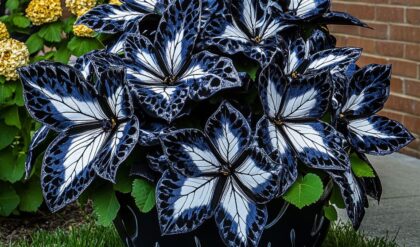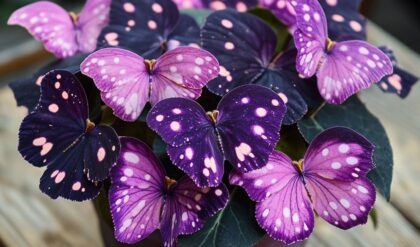Elephant ears, also known as Colocasia or Alocasia, are a stunning tropical plant with large, lush leaves that resemble the ears of an elephant. These captivating plants are a popular choice for gardeners and plant enthusiasts, as they add a bold, dramatic flair to any outdoor or indoor space. Growing elephant ears can be a rewarding experience, but it does require some specific care and attention. In this comprehensive guide, we’ll explore the essential tips and strategies for successfully growing and maintaining these magnificent plants.
Selecting the Right Variety
Elephant ears come in a wide range of cultivars, each with its unique characteristics and growth habits. When choosing the variety that’s right for you, consider factors such as leaf size, color, and overall plant size. Some popular varieties include the classic green-leaved Colocasia esculenta, the striking black-leafed Alocasia ‘Regal Shields,’ and the vibrant Colocasia ‘Illustris’ with its burgundy-hued leaves.

Planting and Soil Requirements
Elephant ears thrive in well-draining, nutrient-rich soil that retains moisture. When planting, choose a location that receives partial to full shade, as these plants prefer to avoid direct, intense sunlight. Amend the soil with organic matter, such as compost or well-rotted manure, to improve drainage and provide the necessary nutrients. Additionally, ensure that the planting area is large enough to accommodate the plant’s expansive growth.
Choosing the Right Pot
If growing elephant ears in containers, select an oversized pot that allows for ample root development. These plants can quickly outgrow their containers, so it’s essential to provide them with enough space to thrive. Use a high-quality potting mix that is well-draining and nutrient-rich to support the plant’s growth.
Watering and Humidity
Elephant ears require consistent moisture to maintain their lush foliage. Water the plants regularly, ensuring that the soil is kept moist but not waterlogged. Aim to water daily, or as needed to keep the soil consistently damp. Additionally, these plants benefit from increased humidity, so consider misting the leaves or using a pebble tray to create a more humid environment.
Fertilizing and Nutrient Requirements
To encourage robust growth and vibrant leaves, fertilize elephant ears every two weeks during the growing season. Use a balanced, water-soluble fertilizer or a slow-release organic option. Ensure that the plant is receiving adequate nutrients, as they are heavy feeders and will quickly deplete the soil’s resources.

Overwintering and Cold Protection
Elephant ears are sensitive to frost and cold temperatures, so it’s crucial to provide them with proper protection during the winter months. In colder climates, you may need to bring the plants indoors or provide insulation around the containers. If planting in the ground, consider mulching the soil around the base of the plant to help insulate the roots.
Preparing for Winter
As the weather begins to cool, gradually reduce watering and allow the foliage to die back naturally. Once the leaves have been killed by frost, cut the plant back to the soil line and carefully dig up the tubers or rhizomes. Clean and allow them to dry, then store them in a cool, dry place until the following growing season.
Dividing and Propagating
Elephant ears can be divided after three years of growth to rejuvenate the plant and promote continued vigorous growth. Carefully lift the entire plant from the ground or container, and use a sharp, clean knife to divide the tubers or rhizomes into smaller sections. Replant the divisions in fresh, nutrient-rich soil and water thoroughly.
Pest and Disease Management
Elephant ears are generally resilient plants, but they can be susceptible to certain pests and diseases. Common issues include aphids, mealybugs, and leaf spot diseases. Monitor your plants regularly and address any problems promptly to maintain their health and appearance.
Controlling Pests
If you notice any signs of pest infestations, such as discolored or damaged leaves, act quickly to address the issue. Use gentle, organic pest control methods, such as insecticidal soap or neem oil, to eliminate the pests without harming the plant.
Preventing Disease
To prevent leaf spot and other fungal diseases, ensure that your elephant ears are planted in well-draining soil and receive adequate air circulation. Avoid overwatering, and promptly remove any damaged or infected foliage to prevent the spread of the disease.
Transporting and Handling Large Plants
As elephant ears grow, they can become quite massive, making them challenging to move and transport. When relocating your plants, whether indoors or outdoors, be sure to use sturdy, oversized containers and enlist help to safely move the heavy pots.
Careful Handling
When handling large elephant ear plants, be gentle and take care not to damage the delicate leaves or stems. Avoid gripping the foliage, and instead, support the plant from the base or by grasping the container.
Maximizing Portability
To make moving your elephant ears easier, consider using wheeled plant stands or dolly systems. This will allow you to easily transport the plants to their desired location without straining your back or risking damage to the plant.
Conclusion
Growing elephant ears can be a rewarding and enjoyable experience, as these plants add a touch of tropical flair to any garden or indoor space. By following the tips and strategies outlined in this comprehensive guide, you’ll be well on your way to cultivating thriving, vibrant elephant ears that will delight you for years to come. Remember to pay close attention to the plant’s needs, provide the right growing conditions, and handle them with care, and you’ll be rewarded with the stunning foliage that makes these plants such a beloved addition to any gardener’s collection.




